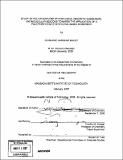Study of poly(phenylene ethynylene)s, dendritic quenchers, and molecular beacons towards the application of a poly(phenylene ethynylene)-based biosensor
Author(s)
Bailey, Ghislaine Caroline
DownloadFull printable version (27.38Mb)
Other Contributors
Massachusetts Institute of Technology. Dept. of Chemistry.
Advisor
Timothy M. Swager.
Terms of use
Metadata
Show full item recordAbstract
Poly(para-phenylene ethynylene)s (PPE)s are highly emissive conjugated polymers that are easily quenched by target analytes. As a result, they have been increasingly incorporated into sensing platforms, both as chemosensors and as biosensors. This thesis describes the three components necessary for a MB-based PPE biosensor, as well as preliminary work towards assembly of the components. A sensor system composed of three parts is presented: (1) a PPE with masked pendent maleimide groups for bioconjugation, (2) a dendritic quencher (DQ) that will be crucial for signal transduction, and (3) a DNA sequence known as a molecular beacon (MB) selective for Escherichia coli 0157:H7. In order to continue expanding the scope of PPEs in sensor applications, new handles are required with which to manipulate the polymers. These handles should be designed so as to tether small molecules, cross-linkers, and biomolecules, such as DNA, to the polymer. To this end, a PPE containing pendent maleimide units has been designed and synthesized. The maleimide group was protected as the Diels-Alder adduct with furan to prevent the maleimide from interfering with polymer synthesis. (cont.) The maleimide group was then revealed post-polymerization under relatively mild thermal conditions and monitored using thermogravimetric analysis. The ability of this group to bind compounds to the polymer was investigated using a thiol-containing dye. A family of dendritic quenchers (DQs) was designed and prepared. The quenching properties of these compounds were investigated, both in aqueous buffers and in DMF, as well as with PPE-coated microspheres. With the microspheres, amplified quenching was observed with increasing DQ generation. In collaboration with the US Army Solider Systems Center (Natick, MA), a MB sequence selective for E. coli 0157:H7 was designed. The performance of the MB in buffers, its melting profile, and its selectivity for E. coli targets was investigated.
Description
Thesis (Ph. D.)--Massachusetts Institute of Technology, Dept. of Chemistry, February 2007. Vita. Includes bibliographical references.
Date issued
2007Department
Massachusetts Institute of Technology. Department of ChemistryPublisher
Massachusetts Institute of Technology
Keywords
Chemistry.